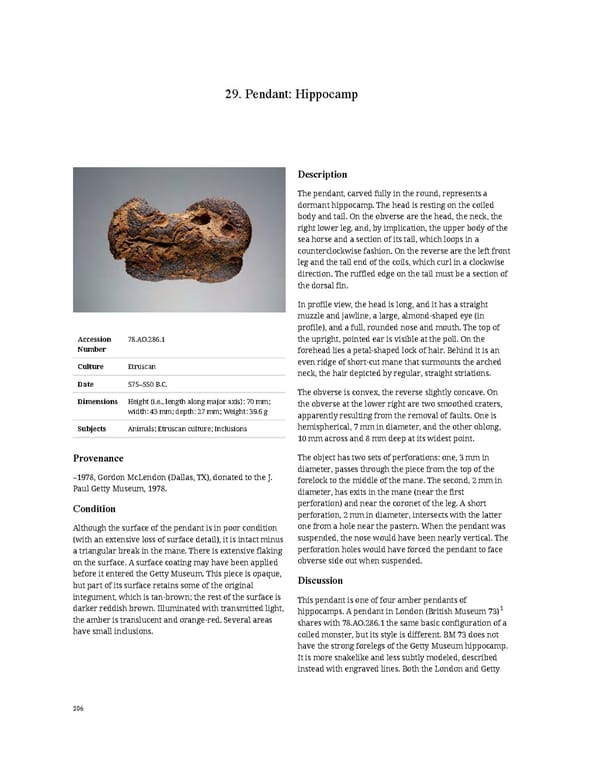29. Pendant: Hippocamp Description The pendant, carved fully in the round, represents a dormant hippocamp. The head is resting on the coiled body and tail. On the obverse are the head, the neck, the right lower leg, and, by implication, the upper body of the sea horse and a section of its tail, which loops in a counterclockwise fashion. On the reverse are the left front leg and the tail end of the coils, which curl in a clockwise direction. The ruffled edge on the tail must be a section of the dorsal fin. In profile view, the head is long, and it has a straight muzzle and jawline, a large, almond-shaped eye (in profile), and a full, rounded nose and mouth. The top of Accession 78.AO.286.1 the upright, pointed ear is visible at the poll. On the Number forehead lies a petal-shaped lock of hair. Behind it is an Culture Etruscan even ridge of short-cut mane that surmounts the arched neck, the hair depicted by regular, straight striations. Date 575–550 B.C. The obverse is convex, the reverse slightly concave. On Dimensions Height (i.e., length along major axis): 70 mm; the obverse at the lower right are two smoothed craters, width: 43 mm; depth: 27 mm; Weight: 39.6 g apparently resulting from the removal of faults. One is Subjects Animals; Etruscan culture; Inclusions hemispherical, 7 mm in diameter, and the other oblong, 10 mm across and 8 mm deep at its widest point. Provenance The object has two sets of perforations: one, 3 mm in diameter, passes through the piece from the top of the –1978, Gordon McLendon (Dallas, TX), donated to the J. forelock to the middle of the mane. The second, 2 mm in Paul Getty Museum, 1978. diameter, has exits in the mane (near the first Condition perforation) and near the coronet of the leg. A short perforation, 2 mm in diameter, intersects with the latter Although the surface of the pendant is in poor condition one from a hole near the pastern. When the pendant was (with an extensive loss of surface detail), it is intact minus suspended, the nose would have been nearly vertical. The a triangular break in the mane. There is extensive flaking perforation holes would have forced the pendant to face on the surface. A surface coating may have been applied obverse side out when suspended. before it entered the Getty Museum. This piece is opaque, Discussion but part of its surface retains some of the original integument, which is tan-brown; the rest of the surface is This pendant is one of four amber pendants of darker reddish brown. Illuminated with transmitted light, hippocamps. A pendant in London (British Museum 73)1 the amber is translucent and orange-red. Several areas shares with 78.AO.286.1 the same basic configuration of a have small inclusions. coiled monster, but its style is different. BM 73 does not have the strong forelegs of the Getty Museum hippocamp. It is more snakelike and less subtly modeled, described instead with engraved lines. Both the London and Getty 206
 Ancient Carved Ambers in the J. Paul Getty Museum Page 215 Page 217
Ancient Carved Ambers in the J. Paul Getty Museum Page 215 Page 217